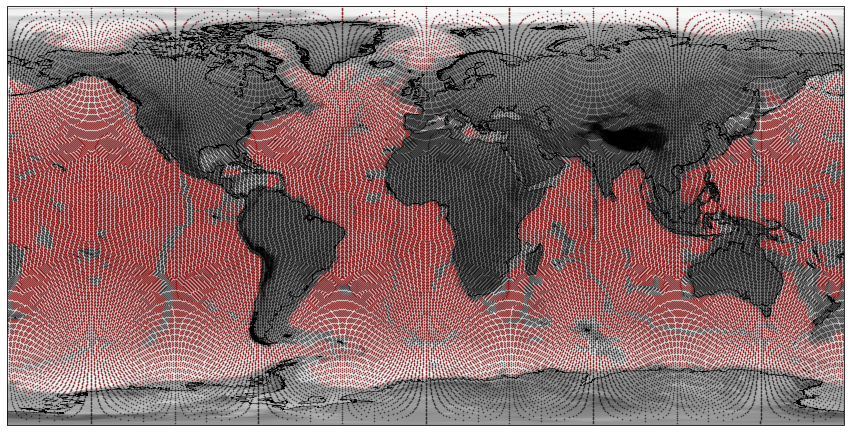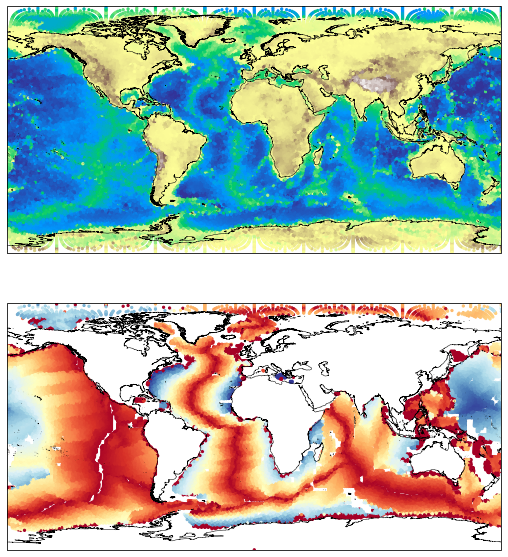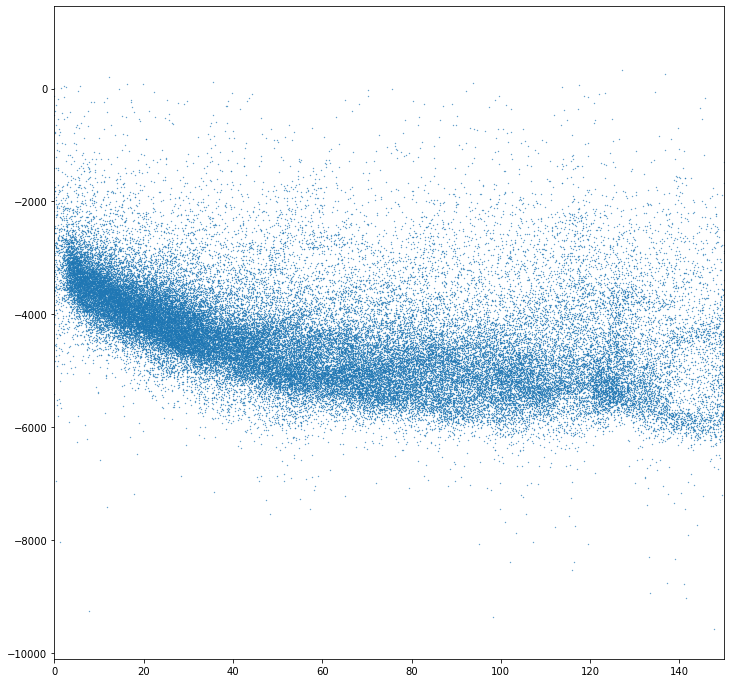Age of the oceans / depth of the oceans
Age of the oceans / depth of the oceans¶
It is well known that ocean bathymetry increases as the square root of the age of the oceanic lithosphere. This can be explained if the oceanic plates form the upper thermal boundary layer of the cooling, convecting mantle.
Most of the data we need to make a simple, first order test of this observation is available to download. We do need some extra tools though - we will have to make sure the age and depth data are sampled at the same points, and we also will need to filter out parts of the Earth’s surface that are not normal ocean floor.
Stripy can help with interpolation / resampling and litho1pt0 (and the crust1.0 regionalisation) allow coarse filtering.
## This is a worked example for stripy if we don't use litho1.0 information
import litho1pt0
import stripy
import numpy as np
import cartopy
import cartopy.crs as ccrs
import matplotlib.pyplot as plt
import xarray
import h5netcdf
(left, bottom, right, top) = (-180, -90, 180, 90)
map_extent = ( left, right, bottom, top)
etopo_dataset = "http://thredds.socib.es/thredds/dodsC/ancillary_data/bathymetry/ETOPO1_Bed_g_gmt4.nc"
etopo_data = xarray.open_dataset(etopo_dataset)
regional_data = etopo_data.sel(x=slice(left,right,10), y=slice(bottom, top,10))
lons = regional_data.coords.get('x')
lats = regional_data.coords.get('y')
vals = regional_data['z']
x,y = np.meshgrid(lons.data, lats.data)
height = vals.data
## Define a regular mesh which we can use to sample the depth-age datasets and the litho 1.0 / crust 1.0 information
even_mesh = stripy.spherical_meshes.icosahedral_mesh(include_face_points=True, tree=True, refinement_levels=6)
number_of_mesh_points = even_mesh.npoints
latitudes_in_radians = even_mesh.lats
latitudes_in_degrees = np.degrees(latitudes_in_radians)
longitudes_in_radians = even_mesh.lons
longitudes_in_degrees = np.degrees(longitudes_in_radians)
# Make an empty array with the same size as the number of mesh points
crusttype = np.empty_like(even_mesh.lats)
# Loop and fill the array with crust regionalisation values
for i in range(0,even_mesh.npoints):
# Note, need 0 -> 360 for litho1pt0 longitudes
crusttype[i] = litho1pt0.crust_type_at(lat=latitudes_in_degrees[i], lon=(longitudes_in_degrees[i]+180))
# Identify which points are "Normal oceanic" crust
ocean_idx = litho1pt0.c1_region_descriptor.index("Normal oceanic")
is_ocean = crusttype == ocean_idx
# Plot this to check the sanity of all the results
import cartopy.crs as ccrs
import cartopy.feature as cfeature
coastline = cfeature.NaturalEarthFeature('physical', 'coastline', '10m',
edgecolor=(1.0,0.8,0.0),
facecolor="none")
plt.figure(figsize=(15, 10))
ax = plt.subplot(111, projection=ccrs.PlateCarree())
ax.set_extent(map_extent)
ax.add_feature(coastline, edgecolor="black", linewidth=0.5, zorder=3)
plt.imshow(height, extent=map_extent, transform=ccrs.PlateCarree(),
cmap='Greys', origin='lower', vmin=-5000., vmax=5000.)
ax.scatter(longitudes_in_degrees, latitudes_in_degrees,
c="black", alpha=0.5,
s=0.5, transform=ccrs.PlateCarree())
ax.scatter(longitudes_in_degrees[is_ocean], latitudes_in_degrees[is_ocean],
c="red", alpha=0.25,
s=0.5, transform=ccrs.PlateCarree())
<matplotlib.collections.PathCollection at 0x7fab81678090>

## Obtain the age data and store in img format
age_dataset = "Data/age.3.6.nc"
age_data = xarray.open_dataset(age_dataset)
subs_data = age_data.sel(x=slice(-180,180, 1), y=slice(-90, 90, 1))
lons = subs_data.coords.get('x')
lats = subs_data.coords.get('y')
vals = subs_data['z']
x,y = np.meshgrid(lons.data, lats.data)
age = vals.data * 0.01
age[np.isnan(age)] = -1.0
## Map heights/ages to the even-mesh grid points
def map_raster_to_mesh(mesh, raster):
latitudes_in_radians = mesh.lats
longitudes_in_radians = mesh.lons
latitudes_in_degrees = np.degrees(latitudes_in_radians)
longitudes_in_degrees = np.degrees(longitudes_in_radians)
dlons = (longitudes_in_degrees + 180)
dlats = latitudes_in_degrees + 90
ilons = raster.shape[0] * dlons / 360.0
ilats = raster.shape[1] * dlats / 180.0
icoords = np.stack((ilons, ilats))
from scipy import ndimage
mvals = ndimage.map_coordinates(raster, icoords , order=3, mode='nearest').astype(np.float)
return mvals
height.shape
(1081, 2161)
meshheights = map_raster_to_mesh(even_mesh, height.T)
meshages = map_raster_to_mesh(even_mesh, age.T)
/Users/runner/miniconda3/envs/conda-build-docs/lib/python3.7/site-packages/ipykernel_launcher.py:20: DeprecationWarning: `np.float` is a deprecated alias for the builtin `float`. To silence this warning, use `float` by itself. Doing this will not modify any behavior and is safe. If you specifically wanted the numpy scalar type, use `np.float64` here.
Deprecated in NumPy 1.20; for more details and guidance: https://numpy.org/devdocs/release/1.20.0-notes.html#deprecations
plt.figure(figsize=(10, 10))
ax1 = plt.subplot(211, projection=ccrs.PlateCarree())
ax2 = plt.subplot(212, projection=ccrs.PlateCarree())
ax1.set_extent(map_extent)
ax1.add_feature(coastline, edgecolor="black", linewidth=0.5, zorder=3)
m = ax1.scatter(longitudes_in_degrees, latitudes_in_degrees,
c=meshheights, cmap="terrain", vmin=-6000.0, vmax=6000.0,
s=5.0, transform=ccrs.PlateCarree())
ax2.set_extent(map_extent)
ax2.add_feature(coastline, edgecolor="black", linewidth=0.5, zorder=3)
m = ax2.scatter(longitudes_in_degrees[is_ocean], latitudes_in_degrees[is_ocean],
c=meshages[is_ocean], cmap="RdYlBu", vmin=0.0, vmax=180.0,
s=5.0, transform=ccrs.PlateCarree())

fig = plt.figure(figsize=(12, 12), facecolor="none")
ax = plt.subplot(111)
ax.scatter(meshages[is_ocean], meshheights[is_ocean],s=0.1)
ax.set_xlim([0.0,150.0])
(0.0, 150.0)

The notebooks in the Tutorial version of this notebook are a self-directed exercise in learning cartopy / stripy in a workflow. Start here